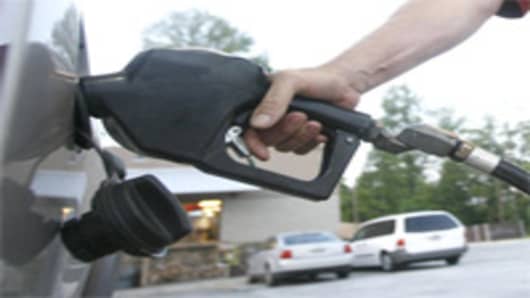Even though the peak driving season is still months away, gasoline prices have been creeping to their highest level since October 2008, and it looks like consumers should brace themselves for higher prices at the gas pump this summer.
"Three dollars a gallon is a virtual done deal," said Stephen Schork, editor of the Schork Report, in an interview on CNBC.
The steep climb in crude oil prices, which are hovering at around $80 a barrel right now — double last year's price at this time — have not fully trickled down to the prices consumers are paying for gasoline or diesel, Schork said.
"That means one of two things: Either crude oil has to fall between now and the Fourth of July, or we need to see a significant rally in pump prices between now and July," Schork said.
The nationwide average has hit $2.799 per gallon, a penny higher than Wednesday, according to AAA, Wright Express and Oil Price Information Service. That means prices have jumped 18.9 cents in the past month and are 87.9 cents higher than year-ago levels. Back on Oct. 23, 2008, prices averaged $2.8215 per gallon.
Schork isn't alone in thinking that pump prices will average more than $3 a gallon by the summer, the Energy Department and many other analysts are saying price could top $3 soon.
Round Earth Capital Chief Investment Officer John Kilduff recently told CNBC that he expects gasoline prices to average at least $3.10 a gallon this summer. What's more, he sees that level as an important tipping point in the mind of consumers, who are still reeling from the weak economy and high levels of unemployment.
"Psychologically, it's going to be horrendous," Kilduff said. He added that he thinks creeping gasoline prices, which have already pushed prices above $3 in some communities, are already eroding consumer confidence.
However, Jason Schenker, president and chief economist at Prestige Economics, disagrees. He expects that while $3 a gallon gas may change the behavior of lower-income consumers, it won't impact others unless prices climb above the $4-mark.
The good news is, Schenker doesn't expect that to happen. Rather, he suspects economic forces aren't there to support $4 a gallon gasoline.
Richard Hastings, a consumer strategist at Global Hunter Securities, also thinks consumers will not be hurt uniformly by higher gas prices.
According to Hastings, the situation now is much different than in past oil price spikes. For one thing, technology has created more home-based businesses and jobs that allow for telecommuting. This reduces the dependancy of consumers on driving to get to their jobs.
Still, lower-income consumers—and the businesses that rely on those consumers—will be vulnerable to the higher prices, he said.
This has already shown up in trends at Wal-Mart Stores , which is highly exposed to shoppers with lower incomes.
He also suspects certain regions of the country are more at risk than others because they have higher rates of unemployment and more exposure to the still-weak construction industry. Those regions would include the West Coast, Southeast and the Industrial Belt of the Midwest.
The National Resources Defense Council, a national environmental action organization, recently did an analysis of the states most vulnerable to high oil prices, ranking states by the percentage of income that the average driver spent on gasoline. (To see the top ten states, click through our slideshow.)
Their analysis also assessed how states would fare if gasoline prices spiked to their 2008 peak levels. This assessment showed that the average driver in Mississipi would spend about 11.07 percent of his or her income on gasoline. In Montana, the percentage was about 10.5 percent.
“We have already been seeing prices ticking upward and we are still in the spring, this augers poorly for what's coming," said Deron Lovaas, the transportation expert at the NRDC.
Demand for gasoline tends to be weaker this time of year, and ramps up as the summer weather increases the number of people travelling on vacations.
According to Kilduff, gasolines supplies are being limited by the refining industry, which is operating at only about 80 percent of its capacity. If this situation does not change, it will become more difficult for refiners to keep up with demand if more consumers hit the road.
Lovaas said he believes the problem rests in consumers having very limited alternatives to gasoline. In many areas, public transportation is scarce.
That's another reason why consumers in some states fare better than others—they have more options as well as more income.
According to NRDC, the ten states least vulnerable to high gas prices (from most to least) are: Florida, Washington, Pennsylvania, New Jersey, Colorado, New Hampshire, Maryland, Massachusetts, New York and the least vulnerable Connecticut.
More from Consumer Nation: Questions? Comments? Email us at consumernation@cnbc.com



